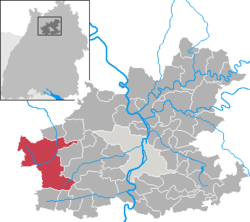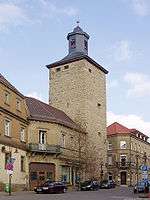Eppingen
![]()
Eppingen | |
|---|---|
 Historic city center | |
 Coat of arms | |
Location of Eppingen within Heilbronn district  | |
 Eppingen  Eppingen | |
| Coordinates: 49°8′N 8°55′E | |
| Country | Germany |
| State | Baden-Württemberg |
| Admin. region | Stuttgart |
| District | Heilbronn |
| Subdivisions | 7 |
| Government | |
| • Lord Mayor | Klaus Holaschke |
| Area | |
| • Total | 88.59 km2 (34.20 sq mi) |
| Elevation | 199 m (653 ft) |
| Population (2018-12-31)[1] | |
| • Total | 21,819 |
| • Density | 250/km2 (640/sq mi) |
| Time zone | CET/CEST (UTC+1/+2) |
| Postal codes | 75031 |
| Dialling codes | 07262, 07260, 07138 |
| Vehicle registration | HN |
| Website | www.eppingen.de |
Eppingen lies in the Kraichgau, a hilly region in southwestern Germany, close to the confluence of the Elsenz and Hilsbach Rivers.
History
Eppingen was first mentioned in 985 when Otto III gave the settlement to the diocese of Worms. The ending "-ingen" was common for towns colonised by the Alamanni clan in the 3rd and 4th centuries.
Eppingen was owned by Salier in the 11th century, and by the Staufer in the 12th century. In 1188, it became a fortified village and, in 1192, a town, elevated by Heinrich VI. The town was distrained several times in the 14th century, but never lost the status of a town. After the win of the Electorate of the Palatinate over margraviate Baden in 1435, it finally became a part of the Electorate of the Palatinate but was once more distrained to the knights of Gemmingen, from 1469 to approximately 1520. In the 15th and 16th centuries, Eppingen underwent an economic boom during which its Latin school was first mentioned (1421). In a time of the plague a part of the Heidelberg University moved to the Latin school in 1496.
During the Palatinate wars of succession, Eppingen functioned as the main storage facility for the German army. From 1695 to 1697, the Eppingen Lines (Eppinger Linien), a string of earthwork fortifications and watchtowers, were built. They served as large defending walls against French raids at that time. One watchtower, called the Chartaque, was built by local students to show the architecture of those ancient buildings. Eppingen was affiliated to Baden in 1803. It maintained the second oldest school of agriculture in Baden. At the end of the 19th century, Eppingen was connected to the railway network; the Kraichgau Railway was opened to Karlsruhe in 1879 and to Heilbronn in 1880 and the Steinsfurt–Eppingen railway, which connected to Heidelberg, was opened in 1899.
During 1971 and 1972, Eppingen annexed the six surrounding communities of Adelshofen, Elsenz, Richen, Rohrbach am Gießhübel, Kleingartach and Mühlbach. In 2000, Eppingen's population exceeded 20,000; and it attained the status of a district town in 2002.
Population Change
|
|
Mayors
- 1808-1813: Heinrich Jakob Raußmüller
- 1813-1816: Carl Morano
- 1816-1831: Ludwig Lother
- 1831-1844: Friedrich Hochstetter
- 1844-1847: Johann Ludwig Raußmüller
- 1847-1859: Wilhelm Lother
- 1859-1866: Gustav Hochstetter
- 1866-1870: Ludwig Lother
- 1870-1878: Heinrich Raußmüller
- 1878-1890: Paul Bentel
- 1890-1894: Heinrich Schmelcher
- 1894-1903: Philipp Vielhauer
- 1903-1933: Albert Wirth
- 1933-1937: Karl Doll
- 1937-1945: Karl Zutavern
- 1945-1948: Jakob Dörr
- 1948-1966: Karl Thomä
- 1966-1980: Rüdiger Peuckert
- 1980-2004: Erich Pretz
- 2004–Present: Klaus Holaschke
Coat of arms
The arms of Eppingen are: Or, a bend gules, impaling sable, an eagle displayed or, wings elevated, armed gules.[2] The city flag is red-yellow.
Economy and Infrastructure
see: Dieffenbacher
Transportation
Eppingen can be reached by A 6 (Mannheim-Heilbronn). Also, the B 293 (Karlsruhe–Heilbronn) goes through to town zone, however it acts as a bypass around the main town area.
Eppingen station is on the Kraichgau Railway, and is served by line S4 of the Karlsruhe Stadtbahn running to Karlsruhe and Heilbronn. It is also connected by the Steinsfurt–Eppingen line to Heidelberg, which is served by line S5 of the Rhine-Neckar S-Bahn.
Landmarks

The Pfeifferturm, a tower built in the 13th century, serves as the town's landmark. The "Old University" (German: Alte Universität) was built in 1494 and 1495 in the style of a late medieval store. Its name is a reminder of the year 1564, when a part of Heidelberg University was moved to Eppingen because of the plague. The Baumann House (German: Baumannsche Haus) is one of the prettiest and most famous timbered houses in the entire area of northern Baden. There are many beautiful timbered houses in downtown Eppingen, and because of this the city is a part of the German 'Fachwerkstraße' (German route of the most beautiful timbered houses).
Town partnerships
Eppingen has official partnerships with:



Sports
The VfB Eppingen is a local football club.
Sons and daughters of the city
- Johan Maurits Mohr (1716-1775), German-Dutch clergyman and astronomer
- Alfred Beck (1889-1957), born in Richen, veterinary physician
- Rosemarie Wenner (born 1955), Bishop of the Evangelical-Methodist Church for Germany
Notes
- "Bevölkerung nach Nationalität und Geschlecht am 31. Dezember 2018". Statistisches Landesamt Baden-Württemberg (in German). July 2019.
- On a shield divided vertically down the middle, to the left a red diagonal stripe on a gold field, to the right on a black field a gold spread-eagle with red beak and claws. The red bend on a gold background is the arms of Baden
- "Epping-Eppingen Town Twinning Association". Archived from the original on 2016-04-15. Retrieved 2014-01-15.
External links
- Stadt Eppingen website (in German)
- Eppingen Local Portal (in German)